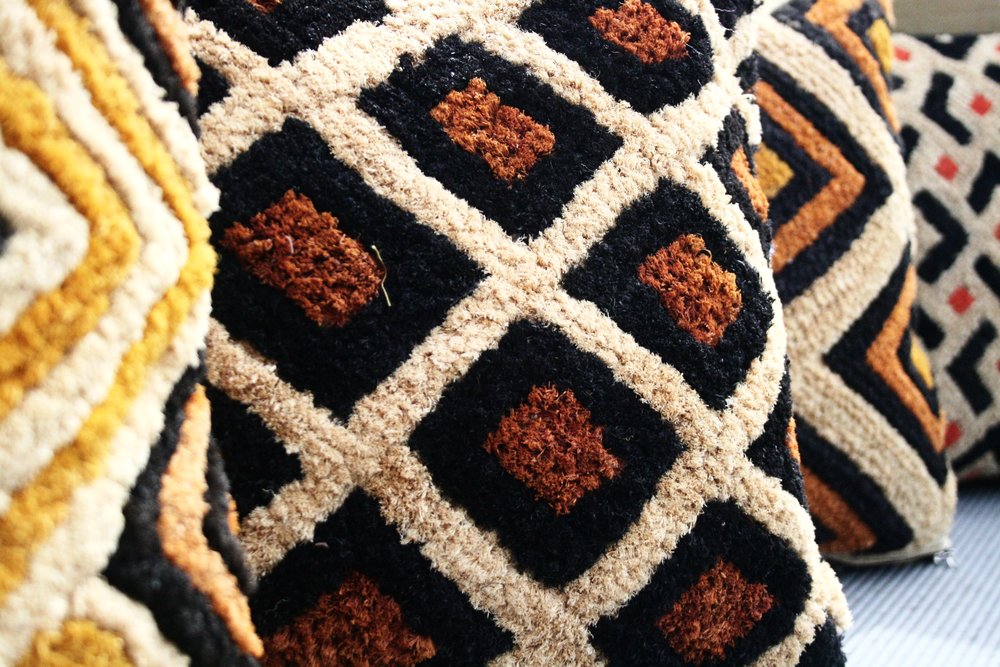The Kuba Textile
A Look at the Artistic Legacy of the Kuba Kingdom
The Kuba people of modern-day Democratic Republic of Congo have a long history of producing exquisite textiles woven from the fibres of the Raphia Vinfera palm tree (raffia). These textiles are a vital part of their cultural heritage and play a significant role in their everyday lives. In this post, we’ll explore the history of Kuba cloth, the making of this remarkable fabric, and its cultural and artistic significance.

Image courtesy of Duarra
African Art Inspiring Global Artists
The beauty of African art has always been a source of fascination around the world, its inspiration visible in even the most avant-garde art of the 20th century. Henri Matisse was a prolific collector of African textiles and objects, and he was captivated by the intricate geometric patterns, bold shapes and colours of the Kuba textile and he incorporated them into his art. He saw the value of African art in general, recognizing its influence on modern art and its ability to inspire creativity.

Today, many artists and designers continue to draw inspiration from the Kuba textile and other African arts, paying homage to their beauty and cultural significance. Modern interior and fashion design feature Kuba fabrics and inspiration regularly. If you know where to look, you will see Kuba and African influence everywhere.
But the Kuba textile is more than just an interesting piece of fabric; it’s a window into the rich artistic legacy of the Kuba Kingdom. One cannot understand Kuba cloth without taking a brief look at the celebrated lands and culture from which it originates.
Henri Matisse in his studio. Image sourced from Pinterest.
The History of the Kuba Kingdom
The Kuba Kingdom is located in the central Congo, between the Sankuru and the Kasai rivers. As strange as it may seem, the Kuba had no name for themselves. The name Kuba was given to them by the Luba, a neighbouring tribe and later adopted by European traders. The Kuba referred to themselves simply as “the people of the King.” By the end of the 19th century, the kingdom was made up of a large number of local ethnic groups that shared language and cultural affinities.

The oldest sample of Kuba cloth. This textile would have been used as an "overskirt." It has been dated to 1736‑1799 and is the oldest piece in the exhibition. Image: Baltimore Museum of Art
The kingdom was created after a migration that started in the Cameroon region where the Benue and the Niger rivers meet. According to oral tradition, Shyaam a-Mbul a Ngoong-Shyaam, the adopted son of a local queen, travelled to the Pende and Kongo Kingdoms to learn how those states were run. Inspired by what he saw, he deposed another local ruler and united all the chiefdoms into a Kingdom dominated by the Bushoong group.
With King Shyaam at the helm, the region became stable, and the kingdom started to blossom. To increase their status, wealthy patrons supported fashion and the arts.
Aristocratic titles ceased to be hereditary and were now given only on merit. Consequently, there was fierce competition to get these lofty titles, and it was undoubtedly one of the main driving forces behind the stunning evolution of the Kuba weaving arts.

Kuba cloth in ceremonial setting. Image sourced from Forbes Africa.
Kuba Culture Expressed Through Textile
The Kuba are renowned for their love of patterns, which are found on an extensive array of objects used for utilitarian and ceremonial purposes. However, it is on the textile that the richest forms of designs are found. Weaving and decorating raffia cloth is an important daily activity for the general population, and the Kuba use a huge amount of textile during ceremonial events. The cloths are wrapped around the waist, layer over layer, and displayed on the body of the deceased during mourning, and buried with the body at the end of the ceremony.
Weaving techniques, dyeing, and decorating developed and improved until the creation of a cloth became one of the most flexible and perennial expressions of human creativity. The Kuba textile is woven on a single, inclined heddle loom, which is set at a different angle than most other looms around the world. An experienced weaver would need two to three hours to complete one piece of cloth. Once a single unit is made, the women dye and embroider it, and these units are sewn together to make a bigger, longer piece of cloth.
The Kuba culture is rich in proverbs that highlight the importance of raffia textile production. An elderly woman or man could say to an unmarried woman, “If you want to marry well, consult the diviner so that you will find a man that will make you a skirt”. The ability to weave a Kuba textile is not only appreciated but might also be seen as an important factor in the provision of social and economic security in the Kuba culture.

From Kuba Kingdom to the World
For hundreds of years, the Kuba textile was unknown to the rest of the world. The Kuba people were able to hold off big incursions due to their central location and the defensive strength of the Kingdom.
The story of the Kuba textile cannot be told without mentioning William Henry Shepperd, the African American Presbyterian priest, explorer, and ethnographer. Shepperd created the first-ever comprehensive collection of Kuba textiles. Born in a relatively well-off family at the end of the civil war in 1865, the Hampton-educated Shepperd went to preach the Christian gospel in Africa in 1890. He was joined in his mission by others who were freed slaves. Shepperd was viewed as one of the greatest missionaries in the world.
In 1890, Shepperd became famous around the world for becoming the first outsider to go deep into the Kuba kingdom and explain its inner workings. He was witness to the last of the great courts in Central Africa as they were before colonization. Thanks to his hard work, Shepperd became a fellow of the Royal Geographic Society in England, a reward he received for his exploration of the Kuba Kingdom.
William Henry Shepperd was instrumental in introducing the art of the Kuba people to the wider world. He generously sold most of his collection to Hampton University in 1911. There were objects not only from the Kuba tribe, but also from the neighbouring tribes like the Luba, Songye and Teke. However the majority were Kuba. These objects included beaded helmet masks, intricately patterned Kuba warrior’s insignia horn and decorated pipe, bowls and cups. Undoubtedly, Sheppard’s Kuba textile collection is the most impressive. The collection has some of the oldest examples of Central African raffia cloth in the world. There’s a piece that could date back from the mid 18th century. These old pieces are vitally important as they illuminated cultural information about the Kuba society to the world.

Kuba cloth in modern decor setting. Image: Duarra
How Kuba Cloth is Crafted
The Kuba textile is made using natural dyes from plants, although those who live in the capital of DR Congo sometimes use synthetic dye more and more. The colour black can be obtained from burnt banana plant leaves and mineral materials, yellow comes from the Rubiacaea plant, and red from Camwood. To dye a piece of cloth or raffia fibers, these ingredients are mixed together in boiling water and cooked until the desired shade is acquired.
There are three major techniques for creating a Kuba textile: appliqué, embroidery, and cut pile. The applique and patchwork are very similar techniques. The former requires attaching additional pieces of fabric to the base cloth to create a patterned effect. The latter involves cutting away pieces of the base cloth to create a pattern, then filling the gaps by patching the front or back of the base cloth with fabric in the shape of the missing piece.
Cut pile technique involves putting Raphia threads in between the cloth layers, creating a raised surface. Once the pile is complete, the excess threads are cut away, creating a plush, velvet-like surface. The embroidery technique involves adding intricate designs to the base cloth using a needle and thread. This technique requires great skill and patience and is often used to create complex and highly detailed designs.
The Kuba textile is not only a means of personal expression but also a reflection of the Kuba people's social and economic structures.

Preserving the Dying Craft of Kuba Cloth Weaving
Despite its popularity in modern design, learning the art of creating Kuba cloth is losing its appeal as more young people leave home to seek employment that will earn them an income. This craft is under threat of being lost forever, as the artisans age without passing on their knowledge.
We’re inspired by brands like Duarra for seeking to preserve this craft and cultural heritage by working with artisans to sell their pieces globally. We’re grateful to Manitou Nsaka, founder of Duarra, for his pocketbook, “The Vanishing Kuba Textile” which has informed the creation of this blog. Discover Duarra’s beautiful Kuba cloth products at Meekono.





